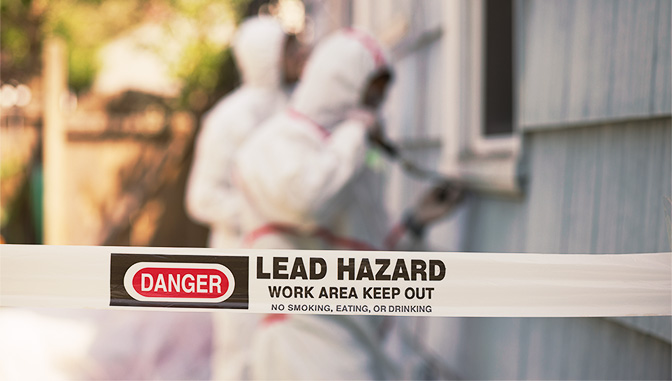EPA’s Move to Reduce Lead Paint Exposure

In December 2017, a federal appeals court, in an unusual move, ordered the Environmental Protection Agency (EPA) to revise within one year a nearly 17-year-old standard for dangerous levels of lead. The federal government banned the use of lead paint 40 years ago, but lead paint and its dangers to the brains of growing children remains a persistent problem.
The ruling mentioned that the EPA has acknowledged that lead paint poisoning was the No. 1 environmental health threat for kids under six and that the current safety standards were insufficient. The EPA’s Renovation, Repair and Painting Program requires that companies performing renovation and repair services that could disturb lead paint in homes, child care facilities, and pre-schools built before 1978 be certified by the EPA, or use certified renovators. According to Michelle DeGarmo of Flatley-Read LLC, a New York state-based compliance management company, “The EPA Renovation, Remodeling, & Painting (RRP) Rule has done a lot to address lead safety outside of HUD programs, and has had the additional benefit of dispelling the persistent myth that only inner-city poor kids get lead poisoning by eating paint chips. While it has its flaws, the RRP rule has increased awareness of lead hazards in the non-HUD consumer population”
Lead is a developmental neurotoxin, and children are the most vulnerable to lead poisoning. Children can be exposed to lead from lead paint in homes or from lead dust, and can contract it from toys and other household sources. There is no post-exposure treatment that can mitigate the long-term neurological effects of lead, so preventing exposure is critical. Unlike other toxins that dissipate, lead has immediate and permanent effects on the brain. Exposure to lead as a child can affect behavior years later, and a recent study published on National Public Radio’s website suggests a link between childhood lead exposure and lowered cognitive ability and socioeconomic status later in life. Aaron Reuben of Duke University studied New Zealand children when they were 11 and determined their IQ scores and cognitive abilities. When the participants turned 38 they were retested; the participants who had higher lead exposure as children, “saw their intellectual abilities decline from their baseline starting point,” as they aged. In addition, the same population experienced a downward trend in social mobility, meaning they were more likely to have jobs that required less education and brought in less income than their parents did. The study found that every 5 microgram increase in lead concentration at age 11 lead to a drop of 1.6 IQ points at age 38.
In the United States., no lead exposure is considered safe, and 5 micrograms per deciliter is considered high exposure. The lingering threat of lead paint is still highly present in the lives of young children, especially in low-income areas and in the Northeast. Lead exposure in the United States has generally decreased, but some communities still have rates of exposure of about five times the national average. The National Center for Health Housing reports children from poor families or those from African-American families are at an increased risk than children from white or Hispanic families. The Harvard Environmental Law Review published a report indicating children from poor communities have the highest prevalence of lead exposure, with non-Hispanic African-American children being three times more likely to have elevated lead levels than their white peers. DeGarmo explains, “Malnutrition is an important factor in childhood lead poisoning prevention. In the absence of necessary minerals, such as iron, our bodies will substitute lead if we are exposed. This is why the poor-kid-myth persists; higher income children are less likely to suffer long-term health effects of lead poisoning because they are typically not malnourished. Lower-income kids are also more likely to live in homes with deteriorated paint, where exposure is consistent over a longer period. Any lead exposure is dangerous, though, and it seems to be only recently that higher-income homeowners have become concerned about lead paint.”
The Harvard Environmental Law Review estimates 23 million homes in the United States contain a lead hazard in some form, and 38 million have lead-based paint somewhere in the home. Under most state and federal laws, the burden of uncovering lead contamination lies with the children, who must be tested before the lead hazard is contained or removed from their environment.
DeGarmo states, “In states that are EPA states, meaning there are no state-specific lead regulations, there is little to no enforcement of the RRP rules, unless federal funding is involved. Rural areas, in particular, have low levels of compliance with the rules. Revised federal standards are particularly important for New York State residents and other EPA states.”
Based on the recent research on the dangers of lead exposure and the lack of clinical treatment options for those who have sustained damage from lead exposure, the move to force the EPA to update its standards is a positive one. Delaying the standards puts even more kids at unnecessary risk.
If you are interested in learning more about how you can impact your community and its health care system, consider a degree in the health sciences from Excelsior College.
Disclaimer: The views expressed here are solely those of the author(s) and do not necessarily represent or reflect the views of Excelsior College, its trustees, officers, or employees.


